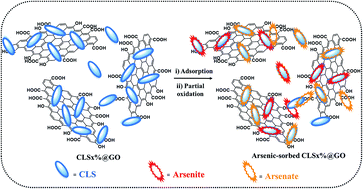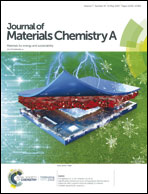Designed synthesis of sulfide-rich bimetallic-assembled graphene oxide sheets as flexible materials and self-tuning adsorption cum oxidation mechanisms of arsenic from water†
Abstract
A superior flexible nanohybrid adsorbent with a double-edged sword structure, consisting of sulfide-rich bimetallic nanopowder of calcium lanthanum sulfide (CaLa2S4, CLS) assembled onto graphene oxide (GO), was successfully synthesized by a wet chemistry method and was used to adsorb both arsenite and arsenate ions from water. GO was used as a structure directing agent as well as a supporting material for CLS. Various amounts (5, 10, 20, and 50% wt/wt) of CLS were introduced on GO surfaces by intercalation to develop a nanohybrid and to investigate the efficiency of toxic arsenite and arsenate removal and surface interaction mechanisms. The CLS material was found to preferentially adsorb arsenate by reactions with calcium and lanthanum, while arsenite was adsorbed by sulfur using Pearson's hard and soft acids and bases (HSAB) principle. Various characterization techniques, such as FTIR, PXRD, Raman spectroscopy, TEM, SEM, XPS, CHS, BET, and zeta potential analyses were utilized before and after the adsorption of arsenite and arsenate. Batch experiment results showed that the CLS50%@GO composite had higher adsorption densities for both arsenite and arsenate than the other developed nanohybrids. Moreover, the Langmuir adsorption isotherm proved to better fit the data than the Freundlich isotherm, yielding maximum adsorption densities of 1.255 mmol g−1 and 1.506 mmol g−1 for arsenite and arsenate, respectively. The interactions between CLS and GO include complexation reactions with carboxyl and hydroxyl groups and a ring opening reaction at epoxy reactive sites along with the intercalation. The PXRD patterns clearly showed that the GO sheets were exfoliated during the loading of CLS with the aid of ultra-sonication which in turn enhanced the adsorption density and kinetic rate. After the adsorption of high concentrations of arsenite/arsenate on CLS50%@GO, the stability of the material was retained, as confirmed by PXRD results. The oxidation of arsenite to arsenate was confirmed by the presence of a new peak at EB[As 3d] = 44.6 eV, supported by C 1s and O 1s spectra in XPS analysis. The results obtained from this study suggest that materials with this type of double-edged sword structure will be useful in practical water purification.



 Please wait while we load your content...
Please wait while we load your content...